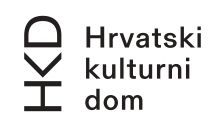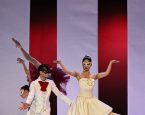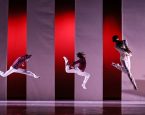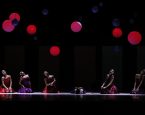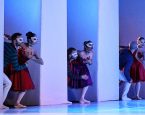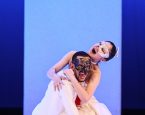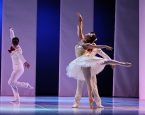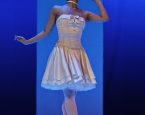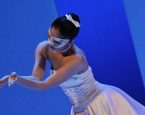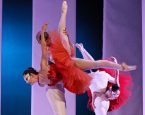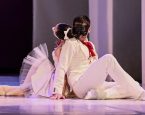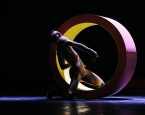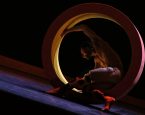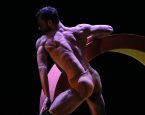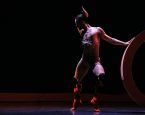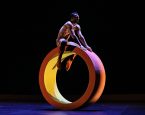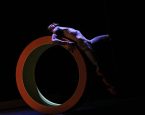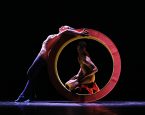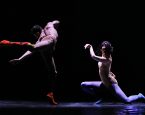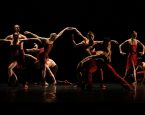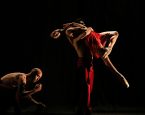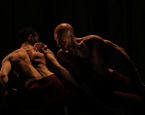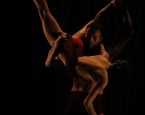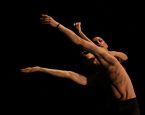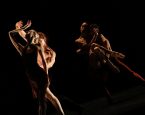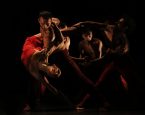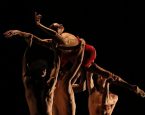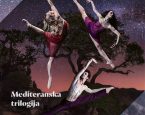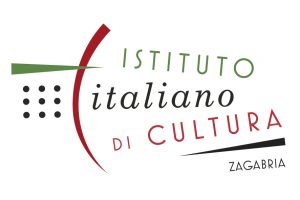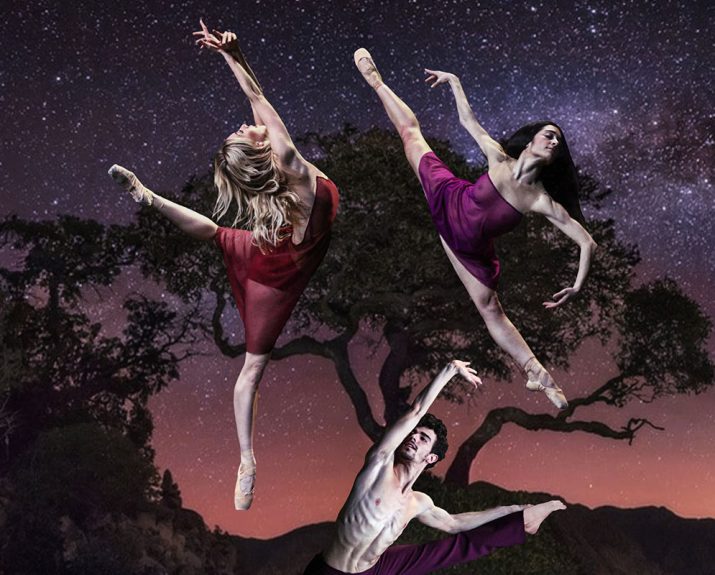
Premiere MEDITERRANEAN TRILOGY: Pulcinella & Afternoon of a Faun & Spanish RhapsodyIgor Stravinsky - Claude Debussy - Maurice Ravel
PULCINELLA
Igor Stravinski, Giovanni Battista Pergolesi
_________
POSLIJEPODNE JEDNOG FAUNA / AFTERNOON OF A FAUN
Claude Debussy
_________
ŠPANJOLSKA RAPSODIJA / SPANISH RHAPSODY
Maurice Ravel
Special thanks to director Edvin Liverić and the technical staff of the Croatian Cultural Center in Sušak for the space provided and assistance with the rehearsals of the show.
With the neoclassical ballet Pulcinella, choreographer Giovanni di Palma breaks out of the stereotype of classical ballet and crosses into the pantomime of comedy dell’arte. We present a proper ballet party for an audience of all generations – one full of exuberance, jokes and quick changes in an extremely well-structured performance.
The composition Prelude to the Afternoon of a Faun by Claude Debussy is one of the most important musical works of the late 19th century and an eternal inspiration for choreographic creations. The symphonic song was created as a free interpretation of verses written by the symbolist Stéphane Mallarmé. Both interpretations of Mallarmé’s song of the same name were the inspiration for the embodiment of a faun in our 21st century choreographed by Maša Kolar. He is a narcissist, smug and autoerotic, all that we witness every day in today’s world bombarded by digital media. Faun is no longer interested in nymphs, he no longer exercises his passions in relation to someone else, but in relation to himself. If the Faun is a symbol of a man torn by opposite extremes, a man between reality and dream, art and eroticism, soul and matter, then we ask ourselves the question whether human instincts are natural and good or uncivilised and bad?
We also present a new choreographer from the European stage, Filipe Portugal, whose Spanish Rhapsody will be performed in the finale of the ballet evening. These three choreographic works under the common title “Mediterranean Trilogy” are conceived as a staging of the beauty and strength of our ballet ensemble.
Giovanni Di Palma creates his version of „Pulcinella“ almost hundred years after the famous ballet impresario Sergei Diaghilev had commissioned the music score from Igor Stravinsky and produced this work for his Ballets Russes. Diaghilev engaged Pablo Picasso as his stage designer and Leonid Massine as choreographer who also participated as a dancer.
Like the original version, the choreography tells the story of Pulcinella – a figure from the Italian Commedia dell‘Arte – , his girlfriend Pimpinella and four other friends. A story of love and jealousy develops, Pulcinella kisses Rosetta and on the climax Pulcinella seems to be stabbed: but it was only a mockery, invented in order to make Pimpinella forgive Pulcinella’s unfaithfulness. One of the friends, masked as a magician, brings Pulcinella back to life. The trick is successful: in the end, Pulcinella and Pimpinella get married, and so do the other couples.
His neoclassical, highly musical choreography fits well with Stravinsky’s music, which was written in the neoclassical period of the composer. His stage design, conceived together with Petra Dancevic in a modernized Renaissance style, with white balloons as many moons and high colums of classical Italy. The bright colours of the costumes, the protagonits with their masks and the drastic changes in lighting recall most elegantly the atmosphere of Commedia dell‘Arte.
The Afternoon of a Faun is a poem by French author Stéphane Mallarmé in which he describes the sensual experiences of a newly awakened faun who discusses his encounters with two nymphs one morning in a dreamy monologue. The admiration we can feel for this dual-natured hero, half-man and half-beast, stems from an unfortunate fate that largely coincides with human destiny. The duality of his being is much more refined for perceptions or feelings on the spiritual plane. Namely, the faun is torn between his animal instincts and erotic instincts that will encourage him to throw himself into the hunt for nymphs, which connects him with matter and his human desires, at the same time making him a being with a soul. As such, he is attracted to the pursuit of perfection and art, symbolized by his flute, which encourages him to desire to touch eternity. (Vrančić, Frano, Characters of Greco-Roman mythology in 19th Century French Poetry). Mallarmé’s faun actually embodies man as an artistic being in all his most varied challenges. The faun experiences nature with the senses, just like an artist. He opens his eyes wide, and the view of nature makes him playful and capricious. The faun is a symbol of a man torn to extremes, a man torn between reality and dream, soul and matter, civilized and animal, or, ultimately, the Apollonian and Dionysian.
It was this poem that inspired Debussy to compose a work that would be considered a turning point in the history of Western art music, perhaps even the beginning of modern music – Prelude to the Afternoon of a Faun. Debussy’s work later served as the basis for the ballet Afternoon of a Faun choreographed by Vaslav Nijinsky, which also marked a turning point in the art of ballet. Just as the flute in Debussy’s prelude brought a new spirit to the art of music and paved the way for modernity, so Nijinsky’s character of the barefoot faun rejected the formalism of classical ballet and created a path for modern dance expression. Of course, such a faun sparked many controversies, one of the biggest of which was the idea of freedom of sexual expression, in which he infused a distinctly erotic subtext in the context of the ancient Greek Arcadia, ending the scene with the faun’s graphic practice of sexual desire.
Both interpretations of Mallarmé’s poem were the inspiration for the embodiment of our faun, the faun of the 21st century. In Maša Kolar’s choreography he is a narcissist, smug and autoerotic, all that we witness every day in today’s world bombarded by digital media. The faun is no longer interested in nymphs; he no longer exercises his passions in relation to someone else, but in relation to himself. If the faun is a symbol of man between reality and dream, art and eroticism, soul and matter, the question arises whether human instincts should be categorized as natural, i.e. “good,” or as uncivilized and therefore necessarily “bad.”
Finding the right music that inspires me has always been the first step in any of my creations. This time, the challenge was to understand how much Ravel’s “Spanish Rhapsody” would inspire me.
Since Masa offered me the opportunity to create a ballet to this particular piece of music, my job was to begin to absorb its essence and understand where this music would take me.
‘Spanish Rhapsody’ takes me to a very mysterious place where I am seduced by the strong, warm blood of the Mediterranean. These were my first thoughts as I listened to it, beginning to grow and figure.
Like painting, my intention was to choreograph very close to Ravel’s musical intensity giving the audience a moving picture to what they are listening to, bringing into this dialogue between music and dance a dramaturgy of its own.
Inspired immensely by the wonderful dancers of the Croatian National Theatre Ivan pl. Zajc, this work could not have been more pleasurable.
Overture: Allegro moderato
1.Serenata: Larghetto: “Mentre l’erbetta”
2.Scherzino: Allegro
3.Allegro
4.Andantino
5.Allegro
6.Ancora poco meno: “Contento forse vivere”
7.Allegro assai
8.Allegro – alla breve: “Con queste paroline”
9.Andante: “Sento dire no’ncè pace”
10.Allegro: “Ncè sta quaccuna po”
11.Presto: “Una te fallan zemprecce”
12.Allegro – Alla breve
13.Tarantella
14.Andantino: “Se tu m’ami”
15.Allegro
16.Gavotta con due variazioni
17.Vivo
18.Tempo di minuetto: “Pupillette, fiammette d’amore”
19.Finale: Allegro assai
What is collaboration with the Rijeka Ballet like? How did you choose the dancers for the roles?
It’s a lot of fun to create with them. I think this is something new for them so they need my encouragement, but their concentration is extremely high. Soloists must have great technique and the skill to dance in a duet, in supports, to withstand the tension to the end. Reactions must be very sharp and precise. I am very happy to have received all this from the Rijeka Ballet.
It’s hard for me to explain why I have chosen someone. They are very high quality and simply attractive. I could feel who was suitable for which role by their energy, by who corresponded to what I imagined. Furthermore, the inner contrasts of ballet dancers are important to me. One example is Laura Orlić, who seems shy but in fact is very strong and sharp. Pimpinella is exactly like that.
When did you fall in love with Pulcinella and Stravinsky?
I’m from Naples. Pulcinella is part of our tradition and I know her very well. I have danced to Stravinsky’s music many times; I adore his diversity and compositions from all his periods. The beautiful music of Pulcinella belongs to the neoclassical.
How does the “comedy of crafts” fit in your choreography?
It must be real, honest, the commedia dell’arte depicts reality in a comic way.
Artists used the comedy dell’arte to comment on their daily lives. We use this in a unique way in this ballet as well – we break out of the stereotype, call it the pantomime of classical ballet, and move on to the pantomime of comedy dell’arte, where bodily expression is most important. Interestingly, since everyone has masks, I took away their ability to communicate with their eyes, but they are accentuated, forming much stronger and more important expressions with their mouths and bodies. They are partly reminiscent of dolls.
Is there a shift in the story or do you stick to tradition?
Pulcinella’s mask is an original, wrinkled face with a big nose. We fully respect the originality of the story just as Stravinsky did, who once modernized Pergolesi’s music. The girls are chic and sexy but also cute, and they also seem superior.
I imagined this ballet as a music box: it appears, develops and falls asleep again. The story is clear and easy for all generations to understand.
Conversation with Andrea Labik
While watching your rehearsal, I experienced the choreography as both neoclassical and modern, refined, with poses that elegantly merge the scenes; they look extremely gentle and extremely demanding, with many beautiful details.
I’m happy to hear you say that. Of course, classical ballet is at my core, however my choreographic work aims to explore my own language. It is natural to draw from one’s own foundations; one should not run away from it. Maša Kolar wanted a part on pointe shoes, which I’m happy about. I generally like to use them in my choreographies because I like the shape of the dancers’ legs in pointe shoes. Also, giving up pointe shoes is easy when you are a modern choreographer – in stockings everything flows easier and more connectedly. On pointe shoes you sometimes can’t achieve that ease. I still believe that we can achieve a lot. Knowing that the Rijeka Ballet has a mostly modern repertoire, dancing en pointe is particularly satisfying and challenging.
How does the Rijeka Ballet respond to neoclassical demands?
I’m not afraid to make demands. They are also used to that material. It’s nice to follow the process from the moment they get used to pointe shoes again to the moment when they no longer even notice them.
Based on your calm, quiet tone at rehearsal, as well as right now, it seems that you very calmly yet clearly are not prepared to make any compromises? 🙂
Exactly. I don’t like to say it has to be this way or that way. There are really many ways to make it the way you envisioned it. I allow myself to be inspired by their personalities.
And there really are a variety of personalities in the Rijeka Ballet. How has your experience been with the Ballet with character?
Everyone is different. It doesn’t always have to be comfortable or easy to deal with their personalities. Artists are sometimes egocentric and self-centered. Everyone wants to achieve something. It is interesting for me to follow how I react to each of them, how I accept each personality and try to lead, how often a completely different approach is effective. That is inevitable. They are not machines. If I told them to do something and they did it perfectly, where would be the fun in that?!
There is always a way, especially if there is also talent. It’s good that I don’t get upset, but in the end, it’s important that they understand the choreographic thought and manage to perform it deftly. I accept everything they have to offer. I give them the movement, the starting point, and they add something of their own to it. The better I get to know them, the more my knowledge influences how I choreograph.
This is really visible on stage; they often perform exactly the same choreography but present it completely differently.
We work a lot on feelings. Every moment tends to lead the dancer into a feeling, a movement that then melts into something else and flows on…
I wouldn’t like robotic choreography in which everyone does the same thing at the same time. Also, I don’t want them to dance just as if they were alone in front of an audience, but to react to each other, and if they smile at each other and feel connected, that’s wonderful; I want them to enjoy the moment. Every day is different.
You say that your choreography for Ravel’s Spanish Rhapsody had its own dramaturgy. Is there a story there, or…?
There is no story. It has dramaturgy in the sense that it is able to tell a story, but the story is the music itself; I wasn’t trying to create a new one. The music is very famous, mysterious, very seductive. I like to connect with the music I choreograph to. The dramaturgy is within that dialogue. I strive for one to be able to listen to the music and see it in my choreography. Like a living image emerging in front of you. Music is associated with movement; movement and dancers in vivid colors will reveal and hide dark panels; light and shadows will create a story.
When you say “Spanish Rhapsody,” there are already some images and associations in your head. What your choreography depicts is certainly not a cliché to be associated with that phrase. It’s different. Unexpected.
I didn’t want to be a slave to expectations. I wanted to offer something different. There are some starting points that one would associate with Spain, but it evolves into something different.
When you create a new work, how much time do you spend per day with the music you’re choreographing to? You’ve also worked on the music of Shostakovich and Bach and Glass and Pärt and Richter and Adams and Sibelius and Debussy and Piazzola and Khachaturian and Wagner…
I listen to that music constantly. And images keep popping up. I become one with the music. My choreographic material definitely comes from listening to the music. Whatever period it is from, it is important to me that it touches and affects me.
For every choreographer the steps are important. What are your choreographic steps like?
I really care about every step and the way I connect them. Dancers sometimes don’t care; sometimes it’s just a passage through the choreography from one step to the next. For me, every step is special. I am interested in what we can do and how much we can achieve with each intermediate step.
Sometimes the dancers count steps during the performance on stage, which can be distracting. What do you think about that?
I understand counting, but…when I start working on steps, I already know the music well. Musicality is 50% of the work for the dancers; it is extremely important that they feel the music. For example, as a choreographer I work with the music and not against it, each emphasizing and underlining the other.
You can learn by counting and practicing when you dance, but it’s much better to feel and hear when you dance. As a dancer, I can say that sometimes the music is such that you have no choice but to count, but at some point one should be able to stop counting. I always prefer notes over numbers. Counting becomes the music after a while – if you’re counting, you aren’t listening to the music.
What can worry you as a choreographer? And what would you single out as the choreographic highlights so far?
I don’t perceive my choreographic experience as just a few highlights. Every experience is too important for me. I don’t need a highlight – everything is a highlight. It all means a lot to me.
I first traveled abroad as a choreographer to the USA, to the Charlotte Ballet, and I was worried because I had worked for the Zürich Ballet until then, and I had known all of the dancers by heart – I knew who could do what, what I could expect of them and how they would react. Upon arriving in America, I had the music and choreography, but I was worried about what it would be like to work with dancers whose personalities I didn’t know nor their ways of moving… I realized then that I just have to give myself time to get to know the troupe and slowly start a dialogue, to indulge in the opportunity to get inspired, to take in everything I see and that only then does the choreography take shape. I have wonderful memories from America as well as from China, from Cannes and so on… The images engraved on me of memories with different people in all these places stay with me for a long time. I give so much to every piece I do; I’m in love with music and what develops, and then I have to look away and leave…sad…but in the end, you leave with a nice feeling because you worked and created something.
How do you like it in Rijeka?
I really like Rijeka. It’s special. The Rijeka Ballet is made up of people who have a lot to give.
Conversation with Andrea Labik
Partner of the ballet Pulcinella

